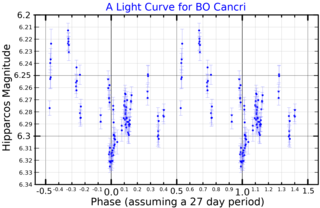Related Research Articles

Gravitational microlensing is an astronomical phenomenon due to the gravitational lens effect. It can be used to detect objects that range from the mass of a planet to the mass of a star, regardless of the light they emit. Typically, astronomers can only detect bright objects that emit much light (stars) or large objects that block background light. These objects make up only a minor portion of the mass of a galaxy. Microlensing allows the study of objects that emit little or no light.

53 Cancri is a variable star in the zodiac constellation Cancer, located around 960 light years from the Sun. It has the variable star designation BO Cancri; 53 Cancri is the Flamsteed designation. This object is a challenge to view with the naked eye, having an apparent visual magnitude around 6. It is around 960 light years away.
MACHO-1997-BLG-41, commonly abbreviated as 97-BLG-41 or MACHO-97-BLG-41, was a gravitational microlensing event located in Sagittarius which occurred in July 1999. The source star is likely a giant or subgiant star of spectral type K located at a distance of around 8 kiloparsecs. The lens star is a binary system approximately 10,000 light-years away in the constellation Sagittarius. The two stars are separated from each other by about 0.9 AU and have an orbital period of around 1.5 years. The most likely mass of the system is about 0.3 times that of the Sun. Star A and star B are both red dwarfs.

V533 Carinae is a white A-type supergiant variable star with a mean apparent magnitude of +4.59 in the constellation Carina. It is over 10,000 light years from Earth.

A circumbinary planet is a planet that orbits two stars instead of one. The two stars orbit each other in a binary system, while the planet typically orbits farther from the center of the system than either of the two stars. In contrast, circumstellar planets in a binary system have stable orbits around one of the two stars, closer in than the orbital distance of the other star. Studies in 2013 showed that there is a strong hint that a circumbinary planet and its stars originate from a single disk.
In astronomy, the MACHO Project was an observational search during 1992-1999 for dark matter around our Milky Way galaxy in the form of hypothetical Massive Compact Halo Objects (MACHOs), using the method of gravitational microlensing. It was one of three first-generation microlensing searches started in the early 1990s, the others being the independent EROS and OGLE projects. The MACHO project was carried out by a team of US and Australian astronomers; observations used the 1.27-metre (50-inch) telescope at the Mount Stromlo Observatory near Canberra, which was dedicated to the project full-time from 1992 until 1999. The project did not solve the dark matter problem, but placed important upper limits on the fraction of dark matter in MACHOs across a wide range of masses, and achieved several notable discoveries in the field of microlensing, and new results on several classes of variable stars.

OGLE-2007-BLG-349(AB)b is a circumbinary extrasolar planet about 8,000 light-years away in the constellation of Sagittarius. It is the first circumbinary exoplanet to be discovered using the microlensing method of detecting exoplanets.
Dr. Sun Hong Rhie was a Korean–American astrophysicist best known for her foundational contributions to the theory of gravitational microlensing, a technique for the discovery of exoplanets.
References
- ↑ Rhie, S. H.; Bennett, D. P.; Becker, A. C.; Peterson, B. A.; Fragile, P. C.; Johnson, B. R.; Quinn, J. L.; Crouch, A.; Gray, J.; King, L.; Messenger, B.; Thomson, S.; Bond, I. A.; Abe, F.; Carter, B. S.; Dodd, R. J.; Hearnshaw, J. B.; Honda, M.; Jugaku, J.; Kabe, S.; Kilmartin, P. M.; Koribalski, B. S.; Masuda, K.; Matsubara, Y.; Muraki, Y.; Nakamura, T.; Nankivell, G. R.; Noda, S.; Rattenbury, N. J.; et al. (2000). "On Planetary Companions to the MACHO 98‐BLG‐35 Microlens Star". The Astrophysical Journal. 533 (1): 378–391. arXiv: astro-ph/9905151 . Bibcode:2000ApJ...533..378R. doi:10.1086/308634. S2CID 204934848.